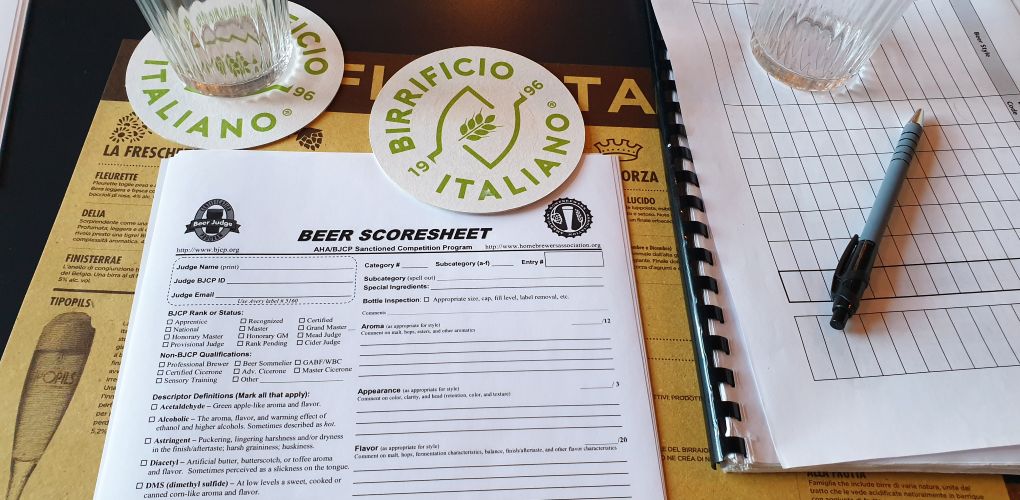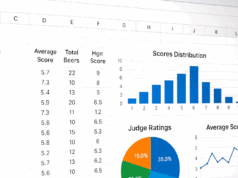I’ve been serving as a judge at domestic and international homebrewing contests ever since I earned my first BJCP rank back in 2017. As a homebrewer, I have also entered my beers in competitions and organized several. I had the chance to read numerous BJCP scoresheets. From extremely poor ones (like these, which I got from a UK competition), to ones that are highly thorough and insightful.
As a judge, I always try to give my best when writing a scoresheet. Keeping focused during a 10 (more often 15) beers flight is no picnic, though. It requires dedication, attention to detail, knowledge, and a lot of practice.
Every scoresheet, beer, and competition teaches us something. Never stop evolving. Always attempt to put yourself in the homebrewer’s shoes. Even though this is typically an unpaid task and there is drinking involved, act professionally. That’s at least what I’m attempting to do. What follows are some lessons I picked up along the way.
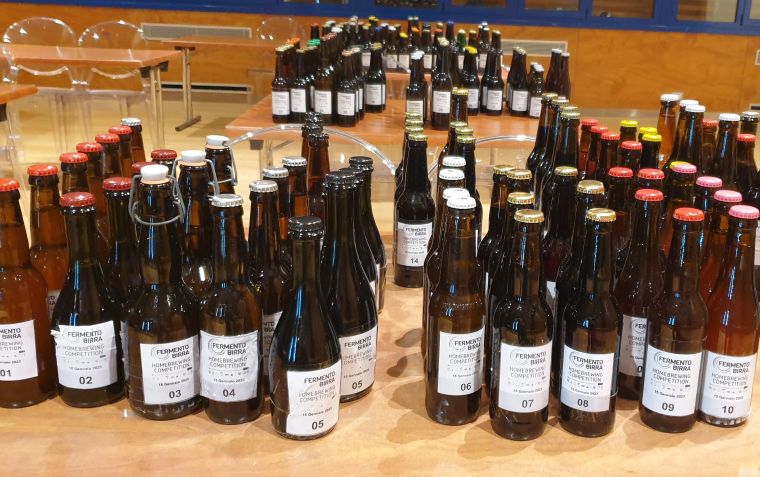
Don’t binge drink the night before judging
Judging beer is a critical task. It’s not only about the judge’s skills: the homebrewer’s talent, abilities, dreams, and artistic creativity are at stake. If a judge doesn’t give it everything he’s got, he’s disrespecting the beer and the homebrewer who made it. During judging, a judge should be in the best condition possible.
I am aware that homebrewing competitions offer a chance to visit new places, take brewery tours, and sample local beers. A beer judge should always be led primarily by curiosity. But be wise. Try to avoid gulping too many pints the night before judging. Socializing is great and it should be always part of a beer trip, but don’t overdo it. Judging beers with a hangover, even a mild one, can detract from the beers you are tasting. Taste buds are a delicate tool, they need to be taken good care of to work properly.
The competition is not focused on the judge. It revolves around the homebrewer who took the time to brew the beer and send it to the competition. Be respectful. Plan your travel so that you may stay for one night after the judging is finished. Make that your party night! Needless to say: in any case, drink responsibly.
While judging, consult the guidelines and stick to them
I’ve seen judges writing odd statements on their scoresheets far too frequently. As a homebrewer, I had the unfortunate experience of receiving scoresheets that deducted points for characteristics that weren’t supposed to be penalizing. Comments such as “this bitter has too low hops aroma“. Yeah, I know, it is clearly stated in the guidelines. So? Why on earth are you detracting points from the aroma?
During a competition, a judge is allowed to read the guidelines. It’s not the Tasting Exam. Where, by the way, proctors are allowed to use the guidelines too, and for the same good reasons. So, refer to them.
There are lots of apps which can easily be at hand on your mobile or tablet. Personally, I always bring my printed guidelines with me, together with highlights and tons of handwritten notes. When I have to judge a beer brewed to a style I am not super familiar with, I give the guidelines a read before starting to judge. By “familiar” I mean that I have judged that style many times, not that I got drunk on it during my traveling.
Personal experience is a crucial item in a judge toolset since it provides context and depth of knowledge about a beer style. Personal memories, however, shouldn’t serve as the standard by which beer is judged. Judges are required to follow the BJCP guidelines. That’s all there is to it. That’s what needs to be done.
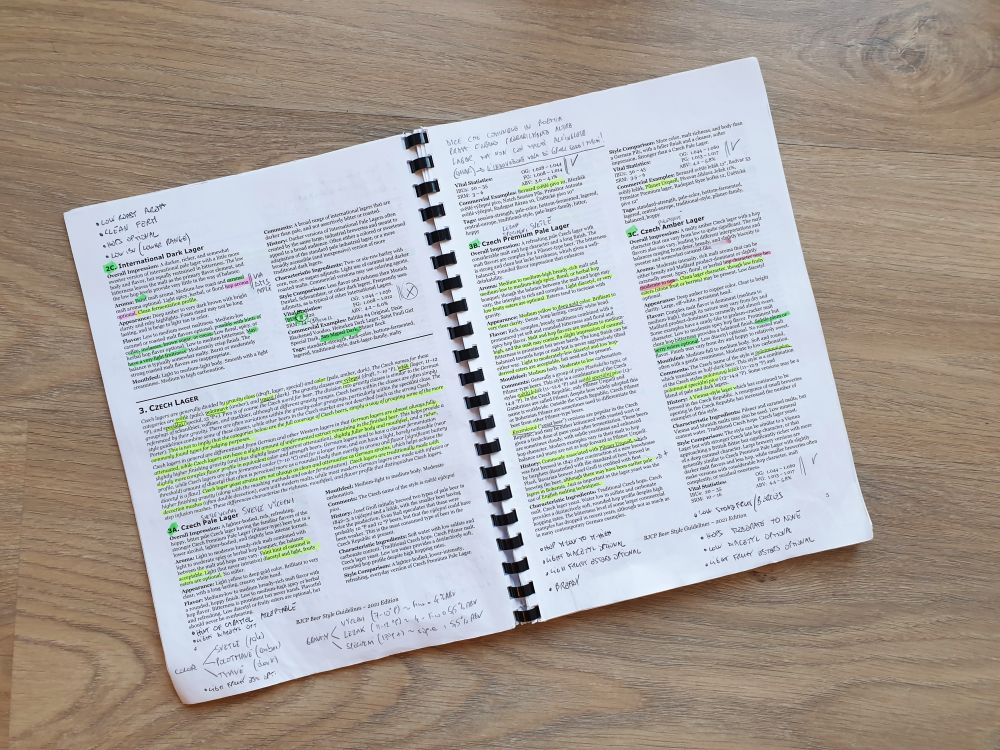
Be detailed and as clear as you can in your writing
The most common piece of advice I heard before sitting for the Tasting Exam was to write clearly. Illegible writing will not be tolerated by the graders. It will take significantly longer to grade an exam if it is difficult to read. The final grade may suffer as a result of poor writing.
It isn’t acceptable to be sloppy just because the people who will receive your scoresheet in a competition won’t be grading you. Homebrewers also deserve fair writing. As judges, we are performing a service for them and it should be a decent one. Illegible writing won’t do any service, it would be a waste of time for everyone involved.
I am a 46 years old “digital” person who grew up in the era of the Internet. I had lost a lot of my handwriting habits before joining the BJCP. During meetings at work, I largely scribbled notes for myself that were frequently unreadable (even to me). I am a fan of writing digitally, I do it daily for business and on this blog. However, digital BJCP scoresheets are not currently widely available and probably won’t be for a while.
So let’s do our work properly. Let’s make an effort to write a decorous scoresheet.
Don’t waste scoresheet space guessing what the homebrewer did or did not do
The tasting exam requires the examinee to write on the scoresheet what is wrong with the beer and how to fix the problem. If oxidation is found, the examinee (aka the wanna-be judge) must demonstrate that he understands what it is and how to prevent it. Correct bottle filling, proper storage, serving the beer fresher, preventing hot side aeration, and the like. Since passing the tasting exam is the goal, in this case, it makes sense to demonstrate knowledge.
In my opinion, though, doing such during a competition is a waste of both scoresheet space and judging time. A homebrewer can get knowledge on how to fix the beer by browsing through the vast amount of information available online and in the many beer books currently on the shelves. There is even a whole page on the BJCP website where all the good advice is collected (click here). There is really no need to duplicate that on the scoresheet.
Try to articulate more on the beer, instead. Why did you like the beer or dislike it? If it’s not a 45, we should give advice on how to improve the beer and explain what is lacking. It’s best not to waste space with a list of ways to avoid oxidation or to fix diacetyl. I don’t think they give much value to the scoresheet. They are not personal. They are generic advice that can be gathered everywhere on the internet.
Make an effort to be specific about why you appreciate (or dislike) the beer
Communication is pivotal. As judges, it is our responsibility to explain the grade we gave the beer. It is a competition for homebrewers, they expect some level of eloquence from us. We owe that to them. That is our job (not a paid one, I know, but this is not an excuse to write a crappy scoresheet).
A skilled and experienced judge should write down in detail what the beer is missing. I know that is hard. I am well aware of the work required to rationalize a gut instinct or feeling. It’s the judge’s job, though. I think a judge can’t get away with a cheesy “the beer is good, well crafted, but it misses something“. We, as judges, must know what that “something” is. Put it in writing. Give it your best.
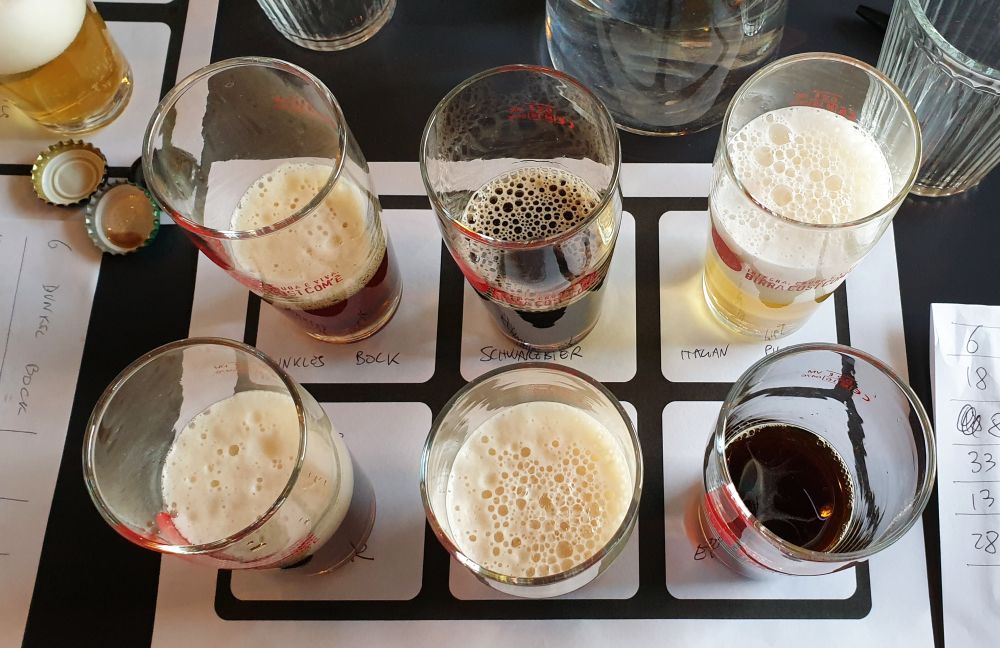
The 45+ score range is there for a reason, use it!
When I took the tasting exam the first time, I was very loose on the numbers. I did not give much thought to the score I assigned to the exam beers. I drifted among the whole scoring range, from the recommended minimum (don’t go under 13 in any case) up to the marvelous 45 and more. This is not the savviest approach for rating the beer during the tasting exam, because you will lose valuable points if your rating differs too much from the proctor’s consensus. The more you span among the grading range, the more the possibilities to move far away.
This is much different during a competition. You won’t be compared to a proctor’s score. Use the whole scoring range. It is ok to stop at 13 as the minimum. It is considered polite, and I’ll go with that. But, for the love of god, don’t stop at 40!
Most of the time, what actually happens in competitions is that the judge acts as though he is attending the Tasting Exam. Why? Because we feel the other judge(s) at the table are judging us. What if I give a 45 and he gives a 30? Will he think I am good at judging or just a joke? Maybe is better to be on the safe side, I’ll go with a 38 so if he gives a 30 we are almost in the 7 points consensus range. I caught myself having thoughts like that, and I wouldn’t say I liked them. It sneaks on you, be bold and shake it off!
Take the risk. Stand up for yourself (and for the beer you are judging). Having a strong and committed opinion is a good thing. Even if it is different from someone else’s. A discussion about a beer brings value to the table. Just be humble, sensitive, and receptive to other people’s ideas. You’ll go home with a broader beer knowledge.
Pay attention when assigning scores
The BJCP Scoresheet is divided into 5 sections. The scoring criteria in each section are different. The range for the aroma is 12, the flavor is 20, the appearance is 3, the mouthfeel is 5, and the overall impression is 10 points. They total 50.
You should refer to the scoring guide, which is located in the bottom left corner of the scoresheet. It could be a little tricky, though. Let’s see why.

The range that is supposedly “Fair” isn’t really that fair. The key word here is “unpleasant“, which does not look fair at all to me. A beer that scores in this range is not fair, it is actually bad. Since no judge assigns scores lower than 13, the “Fair” range serves as a collector for all the bad beers.
In the 2012 scoresheet the word “unpleasant” was not there. It was probably added later on to emphasize the point that a beer in that scoring range is not truly “Fair”. It is barely drinkable.
 The next step, “Good”, is not actually that “good” either. A beer in this range could be good but way out of style (like, say, a Schwarzbier in a German Pilsner category) or not that good, with minor off-flavours. You can have a few sips of a beer in this category, but not drink a whole pint. So, in my opinion (but from what I saw in competitions is common sense), 30 becomes the line of demarcation between a drinkable beer and a “really” good beer.
The next step, “Good”, is not actually that “good” either. A beer in this range could be good but way out of style (like, say, a Schwarzbier in a German Pilsner category) or not that good, with minor off-flavours. You can have a few sips of a beer in this category, but not drink a whole pint. So, in my opinion (but from what I saw in competitions is common sense), 30 becomes the line of demarcation between a drinkable beer and a “really” good beer.
From 30 onwards, you are actually drinking a good beer. On the low end of the range (30-37), it may have very slight off-flavours and could be more of a good beer than a “Very Good” one, but it is definitively a pint that you would finish.
Here we get to the point: scoring consistency.
The Overall Score should, first and foremost, match the Total Score. An I’d-drink-the whole-pint beer should receive at least a 6 on the Overall scale from 1 to 10 (equivalent to 30/50 on the Total Score). Don’t tamper with the Overall Score in an attempt to match the other judge’s score after the tasting. It would mess things up. Try instead to review the other areas, in particular aroma and flavour. Don’t mess with appearance and mouthfeel either, because they are very straightforward: you cannot lower appearance if color, foam, and clarity are ok. It wouldn’t make any sense.
What I usually do is the following.
Appearance and mouthfeel are quite unequivocal, they are just the algebraic sum of their components Quite easy to score. Not easy to change. Your general opinion of the beer should be apparent from the Overall Score. A 5 is a drinkable beer, but you would not finish the pint. A 6 is actually a good one, brewed to style with some minor problems. Below 5 is not that drinkable. 7 is good, 8 very good with no flaws, 9 wow, 10… nobody gives a 10 (but you actually should, if the beer is worth it!).
So, if I need to review my scoring after talking to the other judge, I first work on aroma and flavour. Only if this is not enough, I change the Overall score. If I did that, I might want to rethink what I wrote as well because it might be no more consistent with the scoring. If needed, I can add one or two sentences to the Overall comment to align it with the scoring. Generally, I avoid changing the Overall score after the scoresheet is finished.
I know it sounds cumbersome when judging the 10th beer in a flight. But after a bit of practice, it gets spontaneous and instinctive. The homebrewer will appreciate your consistency. I guarantee that.

